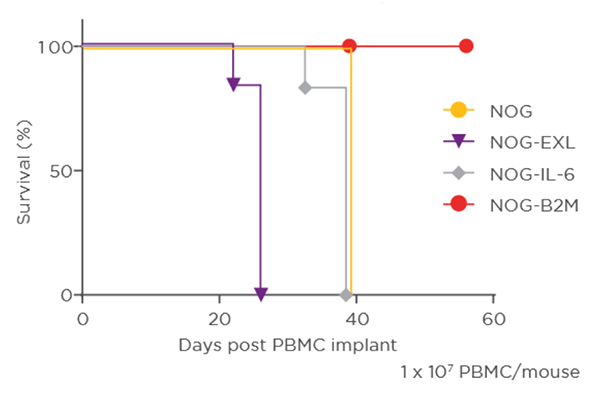 Humanized immune system mice generated by engrafting immunodeficient hosts with human peripheral blood mononuclear cells (PBMCs) have been critical tools for evaluating T-cell dependent immunotherapies. However, novel immunodeficient hosts are demonstrating their ability to extend the utility of PBMC-humanization beyond conventional T-cell focused work.
Humanized immune system mice generated by engrafting immunodeficient hosts with human peripheral blood mononuclear cells (PBMCs) have been critical tools for evaluating T-cell dependent immunotherapies. However, novel immunodeficient hosts are demonstrating their ability to extend the utility of PBMC-humanization beyond conventional T-cell focused work.The hIL-15 NOG mouse carries a transgene expressing human IL-15 and, unlike conventional immunodeficient models, has been shown to facilitate human NK cell reconstitution from engrafted human PBMCs. But what about the other NOG Portfolio models that express human cytokines? What (if any) benefits do these models bring, and how do they compare to Taconic's latest NOG Portfolio model, the B2m-NOG (MHC-I deficient) mouse? Which mouse is "best" for PBMC engraftment?
To help address these questions, Taconic teamed up with Champions Oncology on a study evaluating PBMC-engrafted NOG, B2m-NOG, hIL-6 NOG and NOG-EXL (hGM-CSF & hIL-3 transgenic) mouse models. Both the hIL-6 NOG model and NOG-EXL have been reported to support enhanced support of human myeloid cells from engrafted human CD34+ stem cells. Do they also support myeloid cell engraftment from human PBMCs?
Objectives, experimental design, and study outcomes are summarized below.
Objectives:
This study sought to evaluate and compare NOG, B2m-NOG, hIL-6 NOG and NOG-EXL mouse strains for:
- Ability to support humanization using normal donor PBMCs
- Human immune cell engraftment levels and kinetics
- Types of immune cell subsets supported in each host
- Susceptibility to graft-vs-host disease (GvHD)
Design:
Human PBMCs, isolated by ficoll gradient density separation from a normal donor leukopak, were injected intravenous at 2.5-, 5.0-, or 10-million PBMCs into each NOG strain (n=6 per cell dose). Peripheral blood Immunophenotyping for the presence of T cells (CD3), T cell subsets (CD4,CD8) and myeloid cells (CD33) was performed by flow cytometry on a weekly over an 8-week period.
Experimental Outcomes:
- CD3+ T cells efficiently engraft and expand in all evaluated NOG mouse strains after IV implantation with PBMCs
- CD3 engraftment and expansion was time- and cell dose-dependent and the kinetics of CD3+ subsets varied across the host strains
- NOG-EXL mice had the most rapid in vivo expansion of CD3+ T cells with the highest cell dose (1 × 10^7 mouse) and had the fastest onset of GvHD
- B2m-NOG mice had slower kinetics of engraftment and lower maximal levels of circulating T cells as compared to the parental NOG mice recipients of PBMCs
- B2m-NOG mice facilitated engraftment in the absence of GvHD, thereby offering a longer window for therapeutic interventions
- Human myeloid cells from PBMCs were not supported by any of the evaluated strains, including the strains that support enhanced human myeloid engraftment from CD34+ stem cells (NOG-EXL and hIL-6 NOG)
- Click here to see and evaluate the data yourself, and to determine the best host for PBMC engraftment in your work.
















.jpg)

.jpg)
.jpg)
.jpg)
.jpg)





.jpg)


.jpg)
.jpg)




.jpg)




.jpg)

.jpg)



